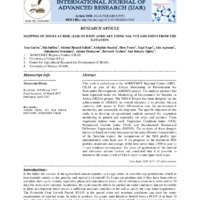Recherche
2 items
Mapping of Zones At Risk (ZAR) in west Africa by using NGI, VCI and SNDVI from the E-statuib
This work is carried out at the AGRHYMET Regional Centre (ARC)-CILSS as part of the African Monitoring of Environment for Sustainable Development (AMESD) project. The analysis protocol has been improved under the Monitoring of Environment for Security in Africa (MESA) project. The MESA Project has been designed on the achievements of AMESD; its overall objective is to provide African countries with access to Earth Observation data for environmental monitoring and sustainable development. The specific objective of this study is to develop an operational analysis protocol for vegetation monitoring in general and especially for crops and pastures. Three vegetation indices were used: Vegetation Condition Index (VCI), Normalized Growth Index (NGI) and Standardized Normalized Difference Vegetation Index (SNDVI). The analysis of these drought indices is based on taking into account the agro-climatic characteristics of the Sahelian region, the comparison of the NGI profile (per administrative unit) from year X (in progress) to the maximum NGI profiles, minimum and average of the time series data (1998 to year x-1) and evidence convergence. Six years of application of the method and validation actions carried out concluded that it is possible to determine the zones at risk (ZAR) in order to anticipate food crises.
Projet MESA, du satellite à la gestion des parcours
Le Projet MESA a pour objectif global d’améliorer les capacités des structures régionales et nationales impliquées dans la gestion de l’environnement, le climat et la sécurité alimentaire dans la zone CEDEAO, plus la Mauritanie et le Tchad, à utiliser l’information issue de l’observation de la terre pour la prise de décision et la planification. Les objectifs spécifiques de la THEMA-CEDEAO sont les suivants:
1. Assurer un accès amélioré et durable des acteurs aux niveaux régional et national aux données d'OT en capitalisant sur les résultats du projet AMESD ;
2. Rendre disponibles les données d'OT et les services améliorés d'information contribuant à une meilleure prise de décision et une meilleure planification;
3. Contribuer à la fertilisation mutuelle en matière de technologie d’Observation de la Terre au niveau continental et dans les institutions régionales et nationales ;
4. Renforcer les cadres de développement de politiques ;
5. Renforcer les capacités des acteurs aux niveaux régional et national en matière d'information relative à l’OT (les sources, les utilisations, les limites, les implications politiques, etc).

